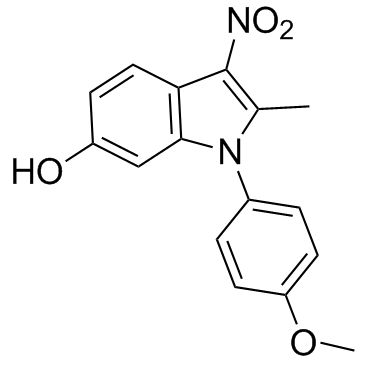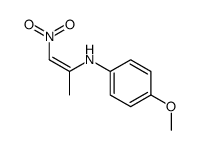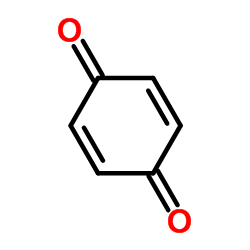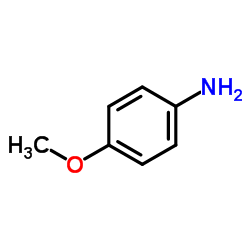ID 8

ID 8 structure
|
Common Name | ID 8 | ||
|---|---|---|---|---|
| CAS Number | 147591-46-6 | Molecular Weight | 298.293 | |
| Density | 1.3±0.1 g/cm3 | Boiling Point | 418.3±45.0 °C at 760 mmHg | |
| Molecular Formula | C16H14N2O4 | Melting Point | 266 °C(dec.) | |
| MSDS | Chinese USA | Flash Point | 206.8±28.7 °C | |
| Symbol |


GHS07, GHS09 |
Signal Word | Warning | |
Use of ID 8ID-8 is a DYRK inhibitor, and sustains embryonic stem cell self-renewal in long-term culture.IC50 Value: Target: DYRKin vitro: the combination of Wnt and ID-8 enhanced hESC replating efficiency, and colonies expressed ALP and displayed undifferentiated morphology. members of the DYRK family are direct targets of ID-8 and that ID-8 enhances Wnt-mediated hESC survival and proliferation via inhibition of DYRKs [1]. ID-8 stimulated proliferation at a steady rate similar to LIF. ID-8 is required to maintain nanog, Sox2, and Rex-1 gene expression [2]. In vivo: |
| Name | 1-(4-methoxyphenyl)-2-methyl-3-nitroindol-6-ol |
|---|---|
| Synonym | More Synonyms |
| Description | ID-8 is a DYRK inhibitor, and sustains embryonic stem cell self-renewal in long-term culture.IC50 Value: Target: DYRKin vitro: the combination of Wnt and ID-8 enhanced hESC replating efficiency, and colonies expressed ALP and displayed undifferentiated morphology. members of the DYRK family are direct targets of ID-8 and that ID-8 enhances Wnt-mediated hESC survival and proliferation via inhibition of DYRKs [1]. ID-8 stimulated proliferation at a steady rate similar to LIF. ID-8 is required to maintain nanog, Sox2, and Rex-1 gene expression [2]. In vivo: |
|---|---|
| Related Catalog | |
| References |
| Density | 1.3±0.1 g/cm3 |
|---|---|
| Boiling Point | 418.3±45.0 °C at 760 mmHg |
| Melting Point | 266 °C(dec.) |
| Molecular Formula | C16H14N2O4 |
| Molecular Weight | 298.293 |
| Flash Point | 206.8±28.7 °C |
| Exact Mass | 298.095367 |
| PSA | 80.21000 |
| LogP | 4.13 |
| Vapour Pressure | 0.0±1.0 mmHg at 25°C |
| Index of Refraction | 1.638 |
| Symbol |


GHS07, GHS09 |
|---|---|
| Signal Word | Warning |
| Hazard Statements | H302-H400 |
| Precautionary Statements | P273 |
| RIDADR | UN 3077 9 / PGIII |
|
~53% 
ID 8 CAS#:147591-46-6 |
| Literature: Lyubchanskaya, V. M.; Alekseeva, L. M.; Granik, V. G. Chemistry of Heterocyclic Compounds (New York, NY, United States), 1992 , vol. 28, # 1 p. 34 - 39 Khimiya Geterotsiklicheskikh Soedinenii, 1992 , # 1 p. 40 - 45 |
|
~% 
ID 8 CAS#:147591-46-6 |
| Literature: Lyubchanskaya, V. M.; Alekseeva, L. M.; Granik, V. G. Chemistry of Heterocyclic Compounds (New York, NY, United States), 1992 , vol. 28, # 1 p. 34 - 39 Khimiya Geterotsiklicheskikh Soedinenii, 1992 , # 1 p. 40 - 45 |
| Precursor 2 | |
|---|---|
| DownStream 0 | |
|
Validation of Perfusion Quantification with 3D Gradient Echo Dynamic Contrast-Enhanced Magnetic Resonance Imaging Using a Blood Pool Contrast Agent in Skeletal Swine Muscle.
PLoS ONE 10 , e0128060, (2015) The purpose of our study was to validate perfusion quantification in a low-perfused tissue by dynamic contrast-enhanced magnetic resonance imaging (DCE-MRI) with shared k-space sampling using a blood ... |
| 1-(4-Methoxy-phenyl)-2-methyl-3-nitro-1H-indol-6-ol |
| 1H-Indol-6-ol, 1-(4-methoxyphenyl)-2-methyl-3-nitro- |
| ID-8 |
| 1-(4-Methoxyphenyl)-2-methyl-3-nitro-1H-indol-6-ol |
| 1-(4-methoxy-phenyl)-2-methyl-3-nitro-1H-indole-6-ol |
| ID8 |


